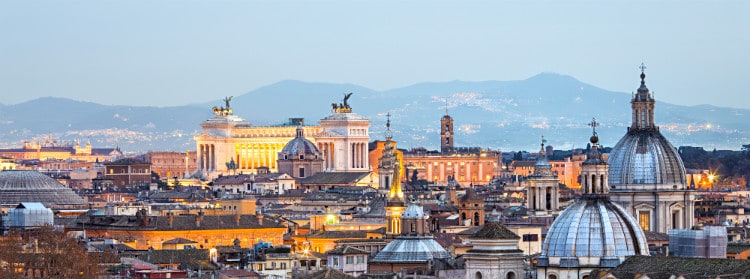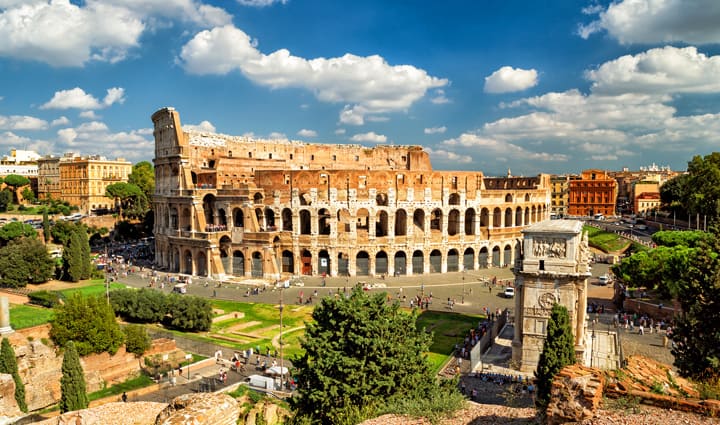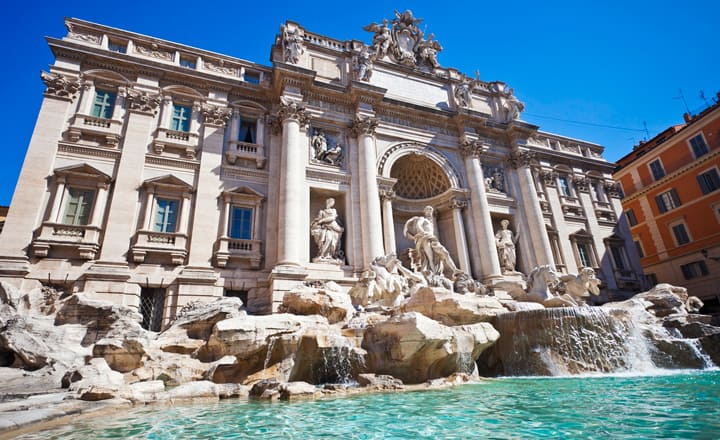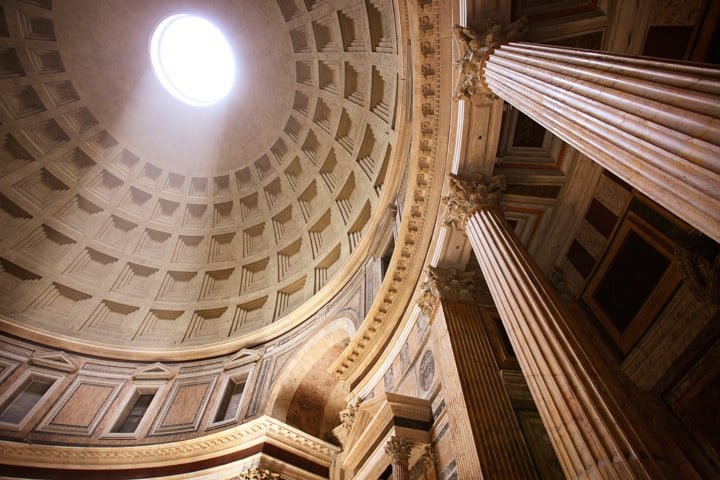
Gay Rome · City Guide
Planning a trip to Rome? Then our gay Rome city guide page is for you.

Rome | Roma
Rome is the capital and largest city of Italy, with a population of around 2.6 million (4.2 million in the metropolitan area). Known as the 'Eternal City', Rome one of the world's most visited tourist destination. Its historic city centre is a UNESCO World Heritage Site filled with famous landmarks, grand palaces, ancient churches, ruins, statues and fountains.
Rome is also recognised as one of the fashion capitals of the world, with a growing nightlife scene and a huge choice of shops, restaurants, bars and cafés.
The city is divided into several districts. Key areas include the Modern Center (Trevi fountain, Piazza della Repubblica), Old Rome (Piazza Navona, Campo de Fiori), the Vatican city, Colosseo, North Center (Villa Borghese, the Spanish Steps), and Trastevere.
 Colosseum
Colosseum
Gay Rights in Italy
Since the introduction of the first Penal Code in 1890, there have been no laws against private, adult and consensual homosexual relations in Italy. The age of consent is 14 years (or 16 if the other person has some kind of influence on the other).
Although same-sex sexual activity is legal, gay rights remain a contentious issue. Many of the anti-discrimination legal protections that have been enacted in other Western European countries don't yet exist in Italy.
However, some progress is being made, albeit slowly. Following a ruling in 2015 by the European Court of Human Rights, a Civil Union law was passed by Italy's Senate, that took effect from June 2016.
A February 2016 poll showed a small majority in favour of gay marriage however less than 40% are in favour of gay parenting. Gay men are not banned from military service but prejudice still exists, and people tend to hide their sexual orientation.
Gay Scene in Rome
The gay scene in Rome is not yet as 'out in the open' as in other European capitals, partly due to the influence of the Catholic Church. Times are changing, however, and, as in many other European countries, a new generation of gay men has emerged who are not prepared to hide in the bushes!
When it comes to masculine affection, there are few inhibitions. Italians do not hold back when it comes to public displays of affection or indeed any other type of emotion.
Gay venues are scattered all over the city, although there is a cluster around the Colosseum and Termini metro station. The small street next to the Colosseum is home to a few Gay Bars.
Romans tend to enjoy a night out at their local cruise bar and sauna more than an evening at a regular gay bar. We suggest that you carefully plan your travels to combine both sightseeing and visiting a Gay Sauna, Cruise club, Bar or Dance Club.
Popular gay events in Rome include the annual open-air summer festival Gay Village, Pride and some other gay festivities.
To enter many adult gay venues (cruise clubs, saunas etc.) in Italy, you will need an ANDDOS club card. You can purchase a card from any participating venue for €8 (valid only at the venue you have joined). You will need a photo ID that shows your date of birth to purchase a card which will be valid for three months.
 Trevi Fountain
Trevi Fountain
Getting to Rome
Rome has two international airports. Leonardo da Vinci/Fiumicino International Airport (FCO) is the main airport with public transport links to the city centre. Ciampino International Airport (CIA), located to the southeast of Rome is served by low-cost airlines. This small airport is closer to the city centre than Fiumicino but has no direct train connection.
From Leonardo da Vinci/Fiumicino airport, there are several ways to get you into Rome:
Leonardo Express train leaves every 30 minutes to the central train station Termini (a 35-minute trip). Beware that these trains arrive at a platform which is a 400m walk from the main station. After you purchase a ticket, get it stamped in a yellow validation machine just before using it. The ticket will expire 90 minutes after validation. Tickets cost 14 euros (2017)
The SIT Bus Service is probably the easiest and cheapest connection between either Fiumicino or Ciampino airports and Rome city center. You can book online or buy the tickets at the airport. The costs €6 from Fiumicino and €5 from Ciampino. Buses leaves near Fiumicino's Terminal 3 (platform 1) and arrives at the Termini station (the same applies for the reverse route). From Ciampino the buses leave from the arrivals area.
Regular Bus Service from both airports to the city is operated by COTRAL/Schiaffini with other companies operating at each airport. Check each individual bus providers websites to find the best fare and timetable to suit you. Don't forget to mark your ticket after getting on the bus.
Taxi is the most convenient option and cost-effective if there are three of you. From Ciampino, prices to the city centre should come to around €35 where as from Fiumicino this can rise to around €55. Taxis should charge a fixed price of €60 for the ride into town at night-time from Fiumicino, but they often try to charge more.
Getting around Rome
Roma Pass
If you are staying in Rome for 3 days or longer, consider buying the Roma Pass (€38.50) which gives you free admission to the first two museums and/or sites you visit, full access to the public transport system, discounts at any other following museums and sites, as well as music events, performances, exhibitions and all other tourist services.
Make sure to check the expiration date at the back of the Roma Pass card.
Taxi
Taxis are the most expensive way to get around Rome but are worth the speed and convenience. Always make sure the driver turns on the meter. Taxis will normally pick you up only at a taxi stand located throughout the city or by calling for one by phone. Flagging down a taxi is possible but rare.
Bus
Buses in Rome are reliable but crowded. Other than walking, they are the cheapest way to get around the city albeit slow due to traffic congestion. Free maps of the bus system are available or can be purchased at Termini station. Single tickets on bus, train, trams and metros in Rome are €1.50 for 100 minutes of travel.
Hop on/hop off bus
A popular alternative to city tour buses are the hop-on/hop-off (Ho-Ho) open-top double-deckers. One good approach for first-time visitors is to ride a complete Ho-Ho loop and make notes of what interests you. Then stay on until you arrive at each point you wish to visit.
Tram
There are tram stops that are convenient for the Vatican, the Colosseum, and the Trastevere area. The number 8 tram runs into Largo Argentina, not far from the Pantheon.
Metro
The Metro is the most punctual form of public transportation in Rome, but it can get super crowded during rush hour. There are two major lines crossing at Termini station: Line A (red line) runs northwest past the Vatican, and southeast, and Line B (blue line) runs southwest past the Colosseum and northeast in one direction, but also splits at the "Bologna" station to go north.
Car
Driving in Rome is best avoided. The traffic is chaotic, the roads are not logical and the signs are few.
On foot
If you are already in the city centre, it is best to walk. When crossing the streets, watch out for the mopeds.
 Pantheon
Pantheon
Where to Stay in Rome
Rome has an excellent choice of accommodations to suit all budgets and tastes. For our list of some of the best hotels for gay travelers, visit the Gay Rome Hotels and Gay Rome Luxury Hotels pages.
Things to See & Do in Rome
- Roman Forum - a fascinating historic site.
- Colosseum - one of Rome's most famous landmarks; once the site of gladiator fights and other enactments.
- Pantheon - Mathematically perfect, it is the largest unreinforced concrete dome in the world.
- The Vatican - a landlocked city state within Rome and the world's smallest independent state by area and population.
- Trevi Fountain - the most famous fountain in Rome. Legend has it that whoever throws a coin into the pond will return to Rome.
- Galleria Borghese - contains exquisite sculptures. Advance reservations required.
- Piazza Navona - thee most outstanding square of the Baroque period in Rome featuring Bernini's Fountain of Rivers.
- Trastevere - lively Italian neighbourhood with people shopping, drinking coffee and going about their daily business.
- Centro Storico - a tangle of narrow streets offering some of the finest examples of Roman classical and Baroque architecture and style.
- Palazzo Massimo alle Terme - Built onto the ruins of the Domitian theater, this palace features beautiful mosaics and Roman statuary
- Basilica di San Clemente - three churches built one above the other, with ruins dating from the earliest Christian times.
- Museo Capitolino - excellent hilltop museum with great views.
Read More: Things To Do In Rome.
When to Visit
The best time to visit Rome is in the spring and summer as the weather is warm and generally sunny. In a good year, the mild weather may continue to December, with occasional cold winds.
In a bad year, there can be heavy rain in October. July and August are usually very hot.
Money
Italy is a member of the euro zone. ATM's (known in Italy as' bancomat') are widely available in Rome and most will accept Visa and MasterCard. You can exchange your money in banks, at post offices or at a 'cambio' (exchange office).
There are exchange booths at Termini station and at Fiumicino and Ciampino airports.
Join the Travel Gay Newsletter
Have we got something wrong?
Are we missing a new venue or has a business closed? Or has something changed and we have not yet updated our pages?Please use this form to let us know. We really appreciate your feedback.